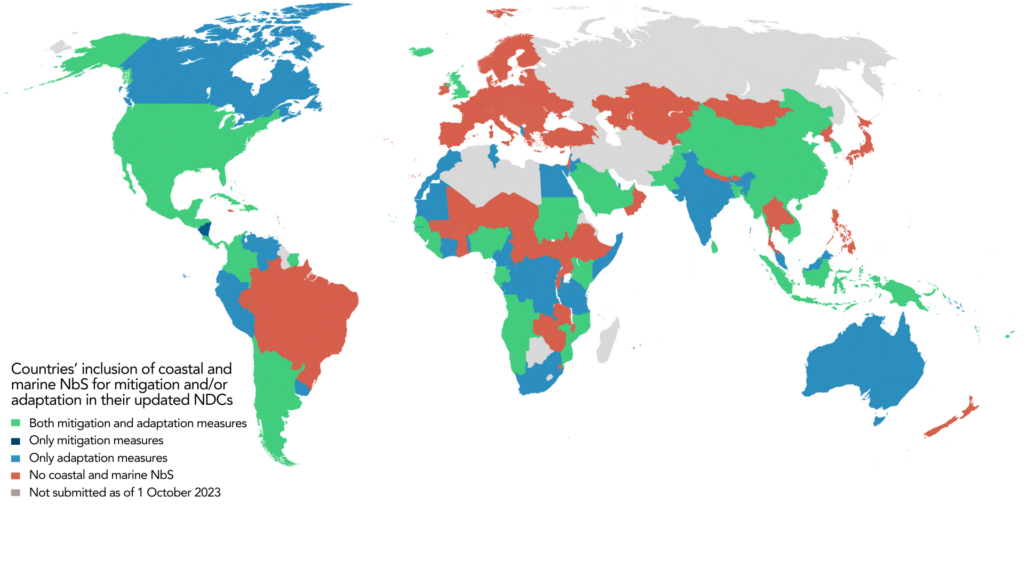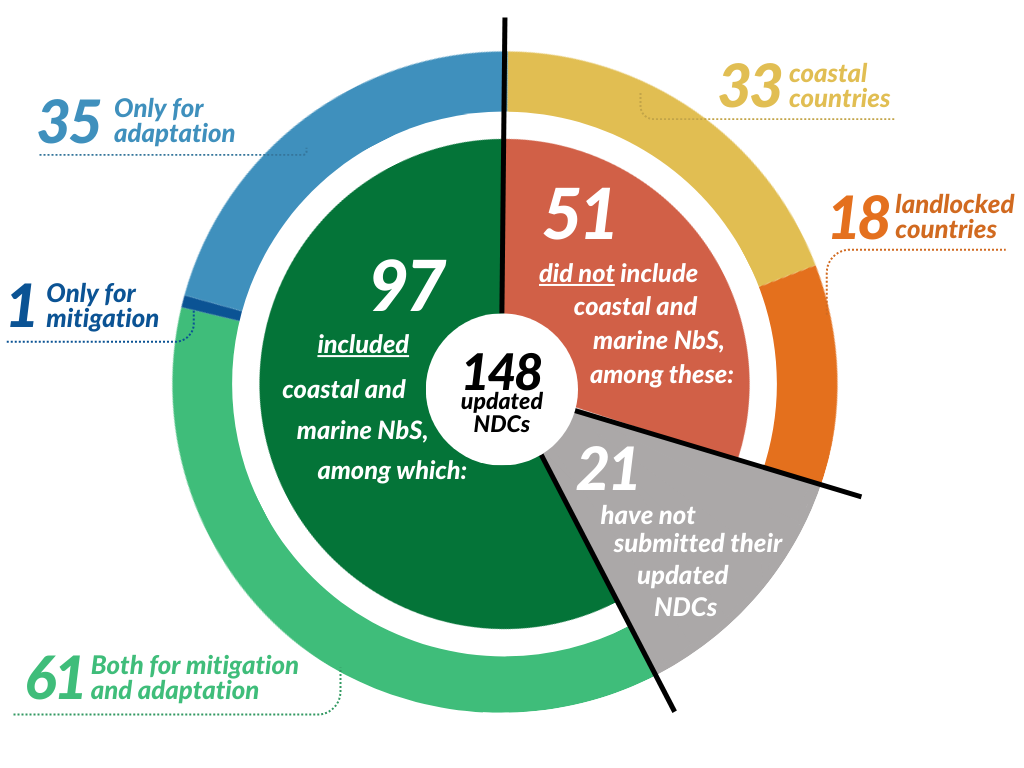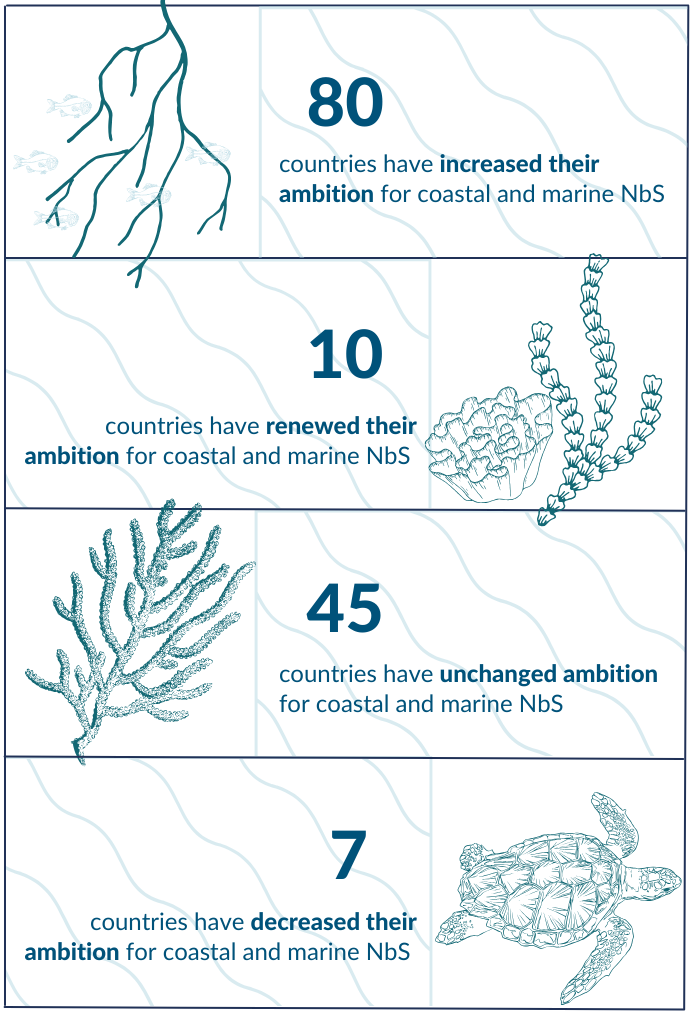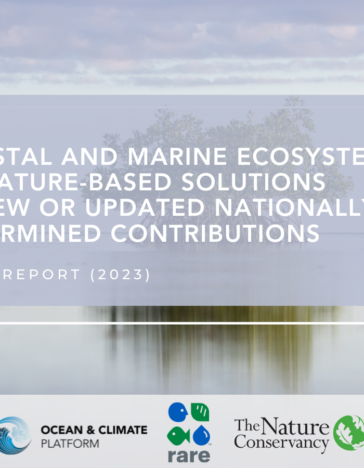
Coastal and marine ecosystems as Nature-based Solutions in new or updated Nationally Determined Contributions
In the context of growing attention to ocean-related measures in climate strategies, it is key to assess the inclusion of coastal and marine ecosystems as Nature-based Solutions in new or updated NDCs.
As part of the Paris Agreement under the Climate Convention, Parties are required to submit updated NDCs every five years, with a review process that is intended to continually increase ambition – known as the Global Stocktake. The first Global Stocktake, which started at COP 26 in 2021, will conclude in a few weeks at COP 28 in Dubai.
This report follows a three-step publication process: (1) the provisional draft published after the UNFCCC intersessions (June 2021), which covered the 63 NDCs submitted until 8 June 2021; (2) the interim draft published at UNFCCC COP 26 (November 2021), which reviewed the 118 NDCs submitted until 21 October 2021; and (3) the present and final report that includes the 148 NDCs submitted by 19 September 2023. A total of 147 countries and the EU-27 (i.e. hereafter referred to as 148 countries) have officially submitted their new or updated NDCs between 29 March 2019 and 19 September 2023.

The report takes a deep dive into new or updated NDCs, looking at the extent to which Parties to the Paris Agreement have included Nature-based Solutions in coastal and marine ecosystems as part of their mitigation and/or adaptation measures.
- Out of 148 countries that have submitted their NDCs as of 19 September 2023, 97 have included coastal and marine NbS. Among these, 61 countries included coastal and marine NbS for both mitigation and adaptation purposes, 1 for mitigation only and 35 for adaptation only.
- Out of these 97, 55 countries recognised the mitigation and adaptation co-benefits of coastal and marine NbS, and 44 noted the resultant socioeconomic benefits for coastal communities.
- In terms of means to enhance coastal and marine NbS in NDCs (i.e. feasibility, societal engagement and transparency), 68 countries are explicitly committed to creating enabling conditions for action (research, technology transfer, capacity-building and finance mobilisation).

In addition, the report provides a robust comparison between first NDCs and updated NDCs. In first NDCs, 68 out of 142 countries included coastal and marine NbS for mitigation and/or adaptation purposes. In comparison, 93 out of 142 countries included relevant coastal and marine NbS in their updated NDCs.
The comparative analysis therefore suggests an overall increase, albeit modest, in recognition of the ocean’s role in climate action, and in countries’ level of ambition with regards to leveraging coastal and marine NbS for climate mitigation and adaptation, specifically:
- More references to the ocean in updated NDCs, i.e. countries further recognised ocean changes (e.g. coral bleaching) and/or climate-driven impacts on the ocean (e.g. sea-level rise). Compared to the first NDCs, 14 out of 142 countries have added such references.
- New coastal and marine NbS as mitigation and/or adaptation efforts in updated NDCs. More than half of the countries have increased their ambition in comparison to their first NDCs, since 80 out of 142 countries added new coastal and marine NbS.
- Additional quantitative targets to support the implementation of coastal and marine NbS, since 33 countries have added numerical targets in relation to coastal and marine NbS (e.g. percentage of coastal wetlands to be protected or hectares of mangroves to be restored).
In addition, the present report provides a robust comparison between first NDCs and updated NDCs, showcasing whether countries have increased, renewed, unchanged or decreased their ambition between first and second submissions. In first NDCs, 68 out of 142 countries included coastal and marine NbS for mitigation and/or adaptation purposes. In comparison, 93 out of 142 countries included relevant coastal and marine NbS in their updated NDCs. The comparative analysis therefore suggests an overall increase, albeit modest, in recognition of the ocean’s role in climate action, and in countries’ level of ambition with regards to leveraging coastal and marine NbS for climate mitigation and adaptation, specifically:
- More references to the ocean in updated NDCs, i.e. countries further recognised ocean changes (e.g. coral bleaching) and/or climate-driven impacts on the ocean (e.g. sea-level rise). Compared to the first NDCs, 14 out of 142 countries have added such references.
- New coastal and marine NbS as mitigation and/or adaptation efforts in updated NDCs. More than half of the countries have increased their ambition in comparison to their first NDCs, since 80 out of 142 countries added new coastal and marine NbS.
- Additional quantitative targets to support the implementation of coastal and marine NbS, since 33 countries have added numerical targets in relation to coastal and marine NbS (e.g. percentage of coastal wetlands to be protected or hectares of mangroves to be restored).


